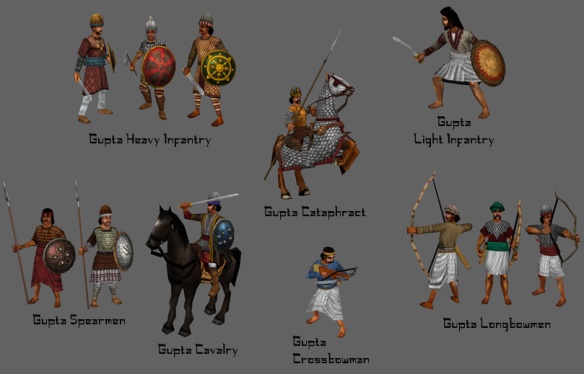
The Imperial Guptas could not have achieved their successes through force of arms without an efficient martial system. Historically, the best accounts of this comes not from the Hindus themselves but from Chinese and Western observers. However, a contemporary Indian document, regarded as a military classic of the time, the Siva-Dhanur-veda, offers some insight into the military system of the Guptas. Like Indian kings before them, and centuries afterwards, the Guptas would have utilized war elephants. These thick hided beasts, supplemented by additional armor and the soldiers that they carried, would have provided a powerful offensive and psychological weapon against an unprepared foe. Another advantage was that they could cause the horses of enemy cavalry to panic from their scent, as the Macedonians discovered. However, their use carried the grave risk of the elephants panicking and stampeding, which more clever opponents used to their advantage.
The use of chariots had heavily declined by the time of the Guptas, having already proved their uselessness against the Macedonians, Scythians, and other invaders. In response, the Guptas seemed to have utilized heavy cavalry clad in mail armor and equipped with maces and lances, who would have used shock action to break the enemy line, much like the clibanarii of the Sassanids and Byzantines in the same era. It is unclear whether they were used to the extent of elephants.
The Guptas seem to have relied heavily on infantry archers, and the bow was one of the dominant weapons of their army. The Hindu version of the longbow was composed of metal, or more typically bamboo, and fired a long bamboo cane arrow with a metal head. Unlike the composite bows of Western and Central Asian foes, bows of this design would be less prone to warping in the damp and moist conditions often prevalent to the region. Iron shafts were used against armored elephants, and fire arrows were also part of the bowmen’s arsenal. Archers were frequently protected by infantry equipped with shields, javelins, and longswords.
The Guptas also had knowledge of siegecraft, catapults, and other sophisticated war machines.
The Guptas apparently showed little predilection for using horse archers, despite the fact these warriors were a main component in the ranks of their Scythian, Parthian, and Hepthalite (Huna) enemies. However, the Gupta armies were probably better disciplined. Able commanders like Samudragupta and Chandragupta II would have likely understood the need for combined armed tactics and proper logistical organization. Gupta military success likely stemmed from the concerted use elephants, armored cavalry, and foot archers in tandem against both Hindu kingdoms and foreign armies invading from the Northwest. Guptas also maintained a navy, allowing them to control regional waters.
The collapse of the Gupta Empire in the face of the Huna onslaught was due not directly to the inherent defects of the Gupta army, which after all had initially defeated these barbarians under Skandagupta. More likely, internal dissolution sapped the ability of the Guptas to resist foreign invasion, as was simultaneously occurring in Western Europe and China.